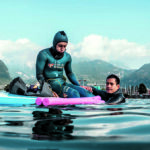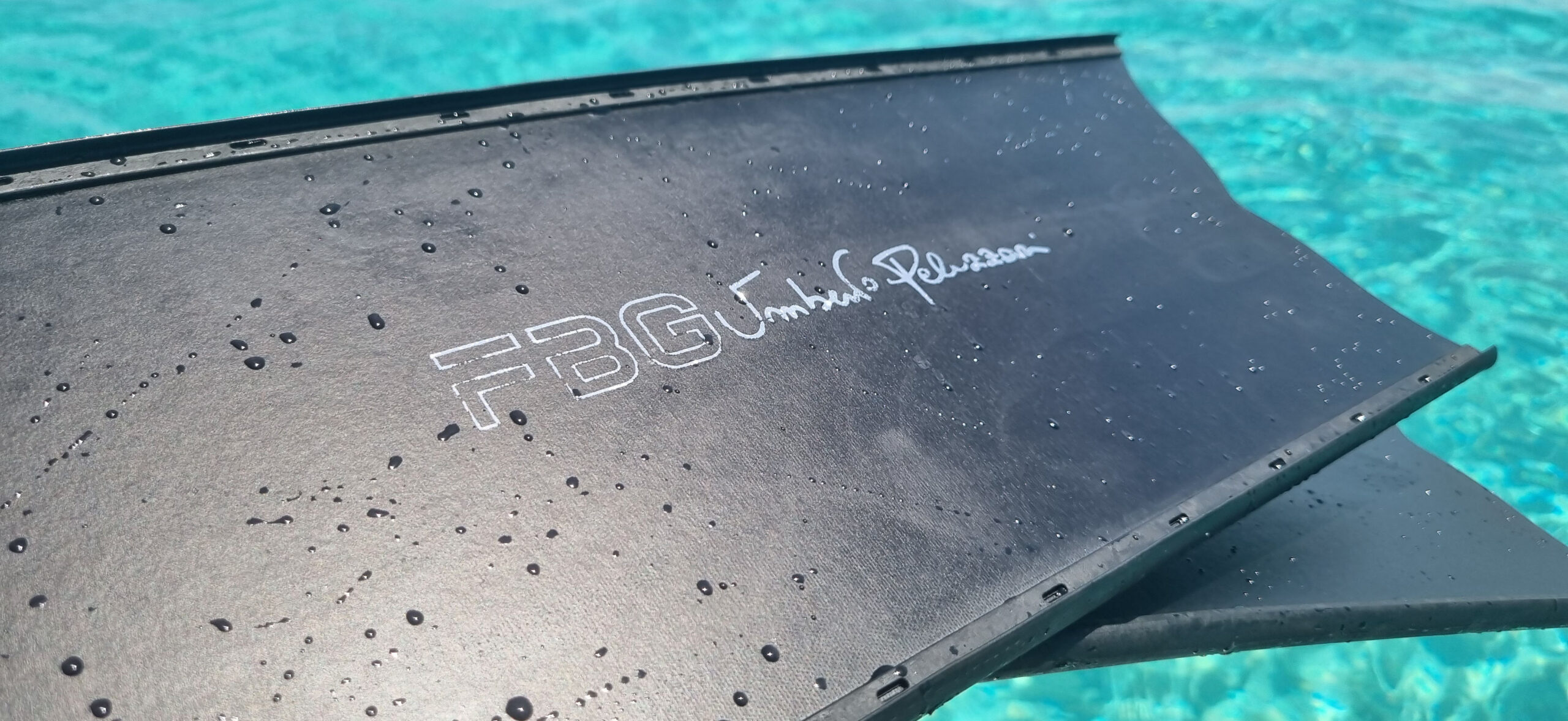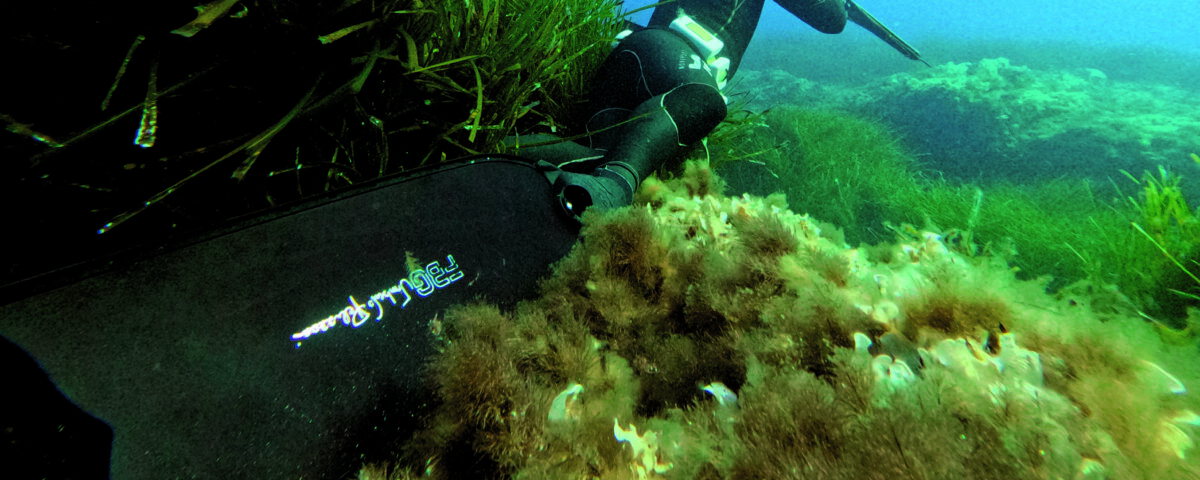C4 Fins: FBG Umberto Pelizzari

Martino Valsangiacomo: From Switzerland to the Depths!
4 September 2025
Tour of Europe: Brittany
10 September 2025This new fiberglass model proved to be surprisingly “energetic” and responsive. The quality-to-price ratio is truly impressive
Jack Cubeddu
In recent years, C4 Carbon has rewritten the rules for improving performance in freediving and spearfishing, thanks to its innovative products. After taking the market by storm with its carbon fiber fins and then with technopolymer models, the company now takes a further step forward by launching a new line aimed at exploring and reaching a different segment.
Enter the brand-new FBG Umberto Pelizzari: C4’s fiberglass offering, entirely designed and manufactured in Italy.
Opening the box, it’s immediately clear this is not a product aimed only at beginners. The blades have an elegant look — a matte total black with the FBG logo engraved in silver at the center of the blade, alongside the clearly visible signature of Umberto Pelizzari. A distinctive mark that combines aesthetics and technical credibility.
Lifting them, the perfect balance between weight, flex stiffness, and build solidity is striking. The blades are made from 100% fiberglass, but manufactured using the same lamination scheme used for C4's carbon models, with a Pre-preg process. This means that even though the material is more affordable, the structure delivers an elastic and high-performance response, ensuring smooth and continuous propulsion throughout the kick cycle.
One of the most notable design elements is the optimized geometry, with a greater thrust surface compared to the hydrodynamic surface.
In the water, this translates into better water capture, a broader surface deformation, and more effective propulsion — all without compromising fin stiffness.
The blades are 79 cm long, offering an excellent balance between power and reduced leg fatigue. The water rails, co-molded (not glued) along the entire length, have a rounded section that helps retain water, reduce side vortices, and improve stability during each kick phase. This is especially helpful for movement in current, long surface swims, or improving cruising speed during descents and ascents.
To further emphasize blade quality, they’re paired with the C4 250 foot pocket, a well-established classic. Lightweight, precise, and comfortable, it's built with carefully selected materials for a natural fit and precise power transfer, aided by a stiff internal sole and minimized side rails.
The FBG comes in nine sizes, from EU 36/37 to 46/47.
C4 offers three different stiffness levels to meet a range of needs: 20 Super Soft – maximum sensitivity and natural movement, ideal for dynamic apnea or training. Also great for women. 25 Soft – balance between comfort and power, suitable for mixed use in pool, open water, and spearfishing. 30 Medium – for those wanting more reactivity and thrust, ideal for demanding dives, longer sessions, or divers with above-average body weight.
The matte black color choice aligns with C4’s identity, where every detail — from blade to foot pocket — serves a functional purpose. The fins come in two colors: Black: designed for spearfishing/freediving White: ideal for freedivin retail price: €179
In the Water
But are the new FBG fins — like most fiberglass products — only suitable for beginners? Or are they ideal across all levels?
Fiberglass has long raised the classic dilemma: is it only for novices, or can it be a valid alternative for those wanting something better than technopolymer without the stress of damaging expensive carbon?
That’s where my test started — not just to evaluate the product but also to give a real answer to this question.
I tested the 25 (Soft) version in two scenarios: Shallow reef areas, involving heavy kicking, impacts, and constant scraping against rocks. Mid-depth spearfishing, requiring rhythm and responsiveness to assess the fin’s effect on my descent and ascent, and especially leg fatigue.
Wearing my usual C4 250 foot pockets (size 41/42) and weighted for shallow water, I started with some low-depth dives to break in and test thrust under load.
Even though I wore a 5mm wetsuit and was slightly over-weighted, the fins performed impressively. Despite their Soft (25) stiffness, the FBGs handled my 70kg body weight + 9kg of lead with ease.
At the surface, the fin responds beautifully, creating perfect synergy between foot power and blade reactivity — without making me miss carbon and letting me forget any worry about wear and tear.
During warm-up dives in the shallows, the fins proved energetic, resisting heavy load and not making me worry about scrapes or contact with rocks.
Then I moved to deeper ground — around 15–20 meters — where rhythm and quick responses are crucial.
This is where the first real surprise came: the thrust during descent was powerful and consistent, allowing me to quickly gain speed and reach neutral buoyancy. During ascent, the kick felt energetic and safe, with no wobble or dead spots.
The Pre-preg lamination process, borrowed from carbon fin construction, results in a fiberglass fin that behaves much more like carbon than technopolymer.
The water rails play a key role, keeping the fins on track during ascent glides and surface movements.
After a few hours of up-and-down diving, I switched back to a pair of carbon fins for comparison. Yes, the difference is noticeable — and it would be dishonest to say otherwise.
However, in all types of diving I performed, I never really felt like I was missing out on anything essential by not having carbon.
My legs showed no signs of fatigue or cramping, thanks also to the comfort of the 250 foot pocket.
It’s clear that C4 Carbon, with the experience of Umberto Pelizzari, has created a fin mainly intended for freediving, but with strong appeal for spearfishing too.
So, what's the final verdict?
FBG fills a market gap between entry-level technopolymer and base-level carbon fins.
C4’s fiberglass solution offers not only an attractive price, but exceptional performance.
The result? Beginners get a great-quality product to grow with.
Experienced spearfishers get a solid alternative for shallow/medium depths, or even a reliable backup fin to keep in the boat or car.
A fin designed to support every freediver’s technical progress — without compromise.
Final Scores
Structure – 9/10
Fiberglass blade with Pre-preg lamination, ensuring consistency, reactivity, and durability. Optimized geometry enhances thrust while maintaining control. Co-molded water rails add effective stability.
Materials – 8/10
Though fiberglass may seem a step down from carbon, the quality of C4’s materials and production makes up for it. 100% made in Italy. Excellent pairing with the 250 foot pocket.
Comfort – 8/10
The foot pocket offers a precise and natural fit, with good power transmission. Nine size options for personalized fit. The blade is reactive but doesn’t tire the leg — a great comfort-performance balance.
Performance – 9/10
FBGs perform impressively well in both shallow and mid-depths. Constant, precise thrust with behavior close to carbon. Powerful push-offs and smooth ascents. Outstanding for a non-carbon material.
Design – 7.5/10
Elegant matte black with silver logo and Pelizzari’s signature. Sober and technical. The design is functional and easy on the eyes, without aggressive styling — all efficiency.
Value for Money – 9.5/10
At €179, the FBGs are positioned in a very competitive price bracket. They offer carbon-like performance with better wear resistance. Ideal for both beginners and pros seeking a versatile, reliable, and affordable option.



